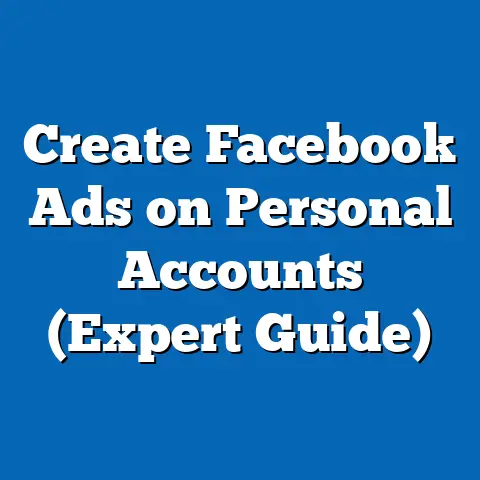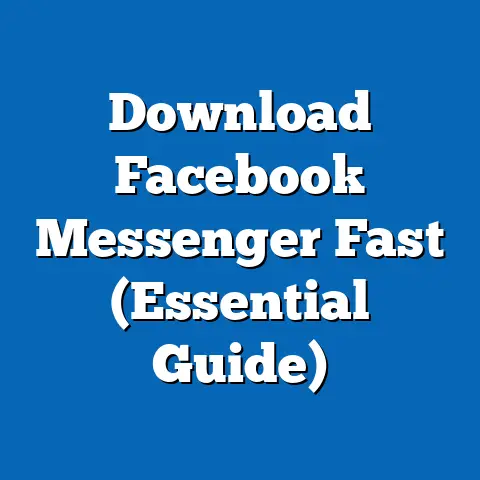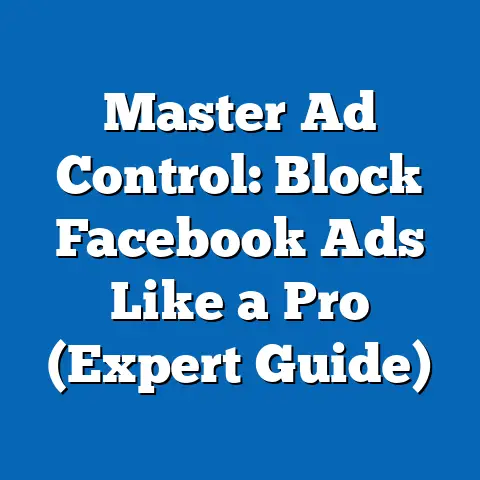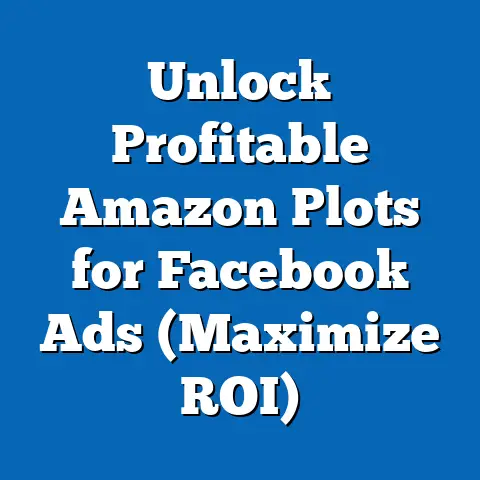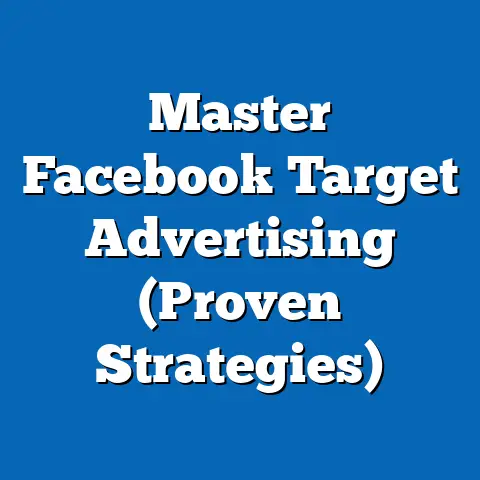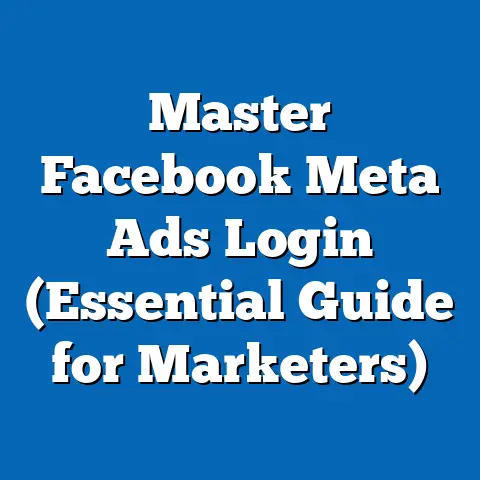Unlock Facebook Ad Choices (Game-Changing Strategies)
Imagine you’re standing before a treasure chest, overflowing with potential riches – but it’s locked. You see intricate carvings, symbols that seem to hold the key to unlocking the treasure within. Facebook advertising is much the same. It’s a vast, powerful platform, brimming with opportunities to connect with your ideal customers and grow your business. But without the right knowledge and strategies, it can feel like you’re fumbling in the dark, unable to unlock its full potential.
I’ve spent years navigating the ever-evolving world of Facebook Ads, and I’ve seen firsthand how understanding the platform’s intricacies can transform a struggling campaign into a roaring success. In this guide, I’m going to share my insights and game-changing strategies to help you unlock the treasure chest of Facebook Ad Choices and achieve your marketing goals.
Section 1: Understanding Facebook’s Advertising Ecosystem
Before diving into the advanced strategies, it’s crucial to build a solid foundation. Understanding the core components of Facebook’s advertising ecosystem is the first step towards unlocking its potential.
1. Overview of Facebook Ads
Facebook Ads are paid messages that businesses can display on Facebook, Instagram, Messenger, and the Audience Network. They’re designed to reach specific audiences with targeted messages, driving traffic, generating leads, and ultimately, increasing sales.
Think of it this way: traditional advertising is like broadcasting a message to anyone within earshot. Facebook Ads, on the other hand, allow you to whisper your message directly into the ear of your ideal customer.
Why are Facebook Ads so important?
- Massive Reach: Facebook boasts billions of active users, offering unparalleled reach to businesses of all sizes.
- Precise Targeting: Facebook’s robust targeting options allow you to pinpoint your ideal customer based on demographics, interests, behaviors, and more.
- Measurable Results: Unlike traditional advertising, Facebook Ads provide detailed analytics, allowing you to track your performance and optimize your campaigns for maximum ROI.
- Flexibility: Facebook Ads offer a variety of ad formats, targeting options, and bidding strategies, allowing you to tailor your campaigns to your specific goals and budget.
The evolution of Facebook Ads has been remarkable. From simple text-based ads to sophisticated video campaigns, the platform has constantly adapted to meet the changing needs of advertisers. Today, Facebook Ads are a dominant force in the advertising landscape, driving billions of dollars in revenue for businesses worldwide.
2. The Importance of Targeting
Audience targeting is the cornerstone of successful Facebook advertising. It’s the process of identifying and selecting the specific groups of people you want to see your ads. Without effective targeting, your ads will be shown to the wrong people, resulting in wasted ad spend and poor results.
“Ad Choices” empower advertisers to refine their targeting and reach the most relevant audience for their campaigns. This includes understanding the various targeting options available, such as:
- Demographics: Age, gender, location, education, relationship status, and more.
- Interests: Hobbies, passions, and topics that your audience is interested in.
- Behaviors: Online activities, purchase history, and other behaviors that indicate your audience’s preferences.
- Custom Audiences: Targeting existing customers or website visitors.
- Lookalike Audiences: Reaching new people who are similar to your existing customers.
Why is targeting so crucial?
- Increased Relevance: Showing your ads to the right people increases the likelihood that they’ll be interested in your product or service.
- Higher Engagement: Relevant ads are more likely to generate clicks, likes, comments, and shares.
- Improved Conversion Rates: When you target the right audience, you’re more likely to convert them into customers.
- Reduced Ad Spend: By focusing your budget on the most relevant audience, you can reduce wasted ad spend and improve your ROI.
I remember working with a small e-commerce business that was struggling to generate sales through Facebook Ads. After analyzing their targeting, I realized they were casting too wide a net, showing their ads to anyone and everyone. By refining their targeting to focus on specific demographics, interests, and behaviors, we were able to significantly improve their conversion rates and reduce their ad spend.
3. Types of Facebook Ads
Facebook offers a variety of ad formats to suit different campaign goals and target audiences. Choosing the right ad format is essential for maximizing your ad’s impact and driving results. Here’s a rundown of the most common Facebook ad types:
- Image Ads: Simple, visually appealing ads that feature a single image and accompanying text. They’re ideal for showcasing products, services, or branding.
- Video Ads: Engaging ads that feature a video and accompanying text. They’re great for telling stories, demonstrating products, or capturing attention.
- Carousel Ads: Ads that allow you to showcase multiple images or videos in a single ad unit. They’re perfect for highlighting different features of a product or service.
- Collection Ads: Ads that feature a hero image or video along with a collection of related products. They’re ideal for e-commerce businesses looking to drive sales.
- Lead Ads: Ads that allow you to collect leads directly within Facebook. They’re great for generating leads for your business.
- Instant Experience Ads: Full-screen, mobile-optimized ads that provide an immersive experience for users. They’re ideal for showcasing your brand and telling your story.
Selecting the Right Ad Format:
The best ad format for your campaign will depend on your specific goals and target audience. Consider the following factors when making your decision:
- Campaign Goals: What are you trying to achieve with your ad campaign? (e.g., drive traffic, generate leads, increase sales)
- Target Audience: Who are you trying to reach with your ad? (e.g., demographics, interests, behaviors)
- Budget: How much are you willing to spend on your ad campaign?
- Creative Assets: What kind of creative assets do you have available? (e.g., images, videos, text)
Key Takeaway: Understanding the different types of Facebook Ads and selecting the right format for your campaign is crucial for maximizing your ad’s impact and driving results.
Section 2: The Mechanics of Facebook Ad Choices
Now that we’ve covered the basics, let’s delve into the mechanics of Facebook Ad Choices. This section will explore how to navigate Facebook Ads Manager, understand Facebook’s algorithms, and unlock valuable audience insights.
1. Navigating Facebook Ads Manager
Facebook Ads Manager is your central hub for creating, managing, and tracking your Facebook ad campaigns. It’s a powerful tool that offers a wide range of features and options, but it can also be overwhelming for beginners.
Here’s a step-by-step guide to navigating Facebook Ads Manager:
-
Accessing Ads Manager: You can access Ads Manager by logging into your Facebook account and clicking on the “Ads Manager” icon in the left-hand menu.
-
Creating a Campaign: To create a new campaign, click on the “Create” button in the top right corner of Ads Manager.
-
Choosing a Campaign Objective: Facebook offers a variety of campaign objectives, such as awareness, traffic, engagement, leads, app promotion, and sales. Choose the objective that best aligns with your campaign goals.
-
Defining Your Audience: This is where you’ll define your target audience based on demographics, interests, behaviors, and more.
-
Setting Your Budget and Schedule: Determine how much you’re willing to spend on your campaign and how long you want it to run.
-
Creating Your Ad: Choose your ad format and create your ad copy and visuals.
-
Reviewing and Publishing Your Campaign: Before publishing your campaign, review all of your settings to ensure they’re correct.
Accessing Ads Manager: You can access Ads Manager by logging into your Facebook account and clicking on the “Ads Manager” icon in the left-hand menu.
Creating a Campaign: To create a new campaign, click on the “Create” button in the top right corner of Ads Manager.
Choosing a Campaign Objective: Facebook offers a variety of campaign objectives, such as awareness, traffic, engagement, leads, app promotion, and sales. Choose the objective that best aligns with your campaign goals.
Defining Your Audience: This is where you’ll define your target audience based on demographics, interests, behaviors, and more.
Setting Your Budget and Schedule: Determine how much you’re willing to spend on your campaign and how long you want it to run.
Creating Your Ad: Choose your ad format and create your ad copy and visuals.
Reviewing and Publishing Your Campaign: Before publishing your campaign, review all of your settings to ensure they’re correct.
Key Features and Tools in Ads Manager:
- Campaign Dashboard: Provides an overview of your campaign performance, including metrics like reach, impressions, clicks, and conversions.
- Ad Sets: Allow you to group your ads based on targeting, budget, and schedule.
- Ads: The individual ads that you’re running within your ad sets.
- Reporting: Provides detailed analytics on your campaign performance, allowing you to track your progress and optimize your campaigns.
- Audience Insights: Helps you understand your target audience’s demographics, interests, and behaviors.
- Pixel: A piece of code that you can install on your website to track conversions and retarget website visitors.
I’ve found that many advertisers overlook the power of the reporting features in Ads Manager. By regularly monitoring your campaign performance and analyzing the data, you can identify areas for improvement and optimize your campaigns for maximum ROI.
2. Understanding Facebook’s Algorithms
Facebook’s algorithms play a crucial role in determining which ads are shown to which users. Understanding how these algorithms work is essential for maximizing your ad’s visibility and driving results.
How Facebook’s Algorithms Work:
Facebook’s algorithms are designed to deliver the most relevant and engaging content to each user. This includes both organic content (posts from friends and family) and paid content (ads).
When determining which ads to show to a user, Facebook considers a variety of factors, including:
- Relevance: How relevant is the ad to the user’s interests and behaviors?
- Engagement: How likely is the user to engage with the ad (e.g., click, like, comment, share)?
- Bid: How much is the advertiser willing to pay to show the ad to the user?
- Ad Quality: How high quality is the ad (e.g., clear visuals, compelling copy)?
Impact of Engagement Metrics:
Engagement metrics play a significant role in determining ad performance. Ads that generate high engagement are more likely to be shown to more users and at a lower cost.
Here are some key engagement metrics to track:
- Click-Through Rate (CTR): The percentage of people who see your ad and click on it.
- Cost Per Click (CPC): The amount you pay each time someone clicks on your ad.
- Conversion Rate: The percentage of people who click on your ad and complete a desired action (e.g., make a purchase, fill out a form).
- Relevance Score: A score that Facebook assigns to your ad based on its relevance to your target audience.
Optimizing for the Algorithm:
To optimize your ads for Facebook’s algorithms, focus on creating high-quality, relevant ads that generate high engagement. This includes:
- Targeting the Right Audience: Make sure you’re showing your ads to the people who are most likely to be interested in your product or service.
- Creating Compelling Ad Copy and Visuals: Write persuasive ad copy that captures attention and drives clicks. Use high-quality visuals that are relevant to your target audience.
- A/B Testing Your Ads: Experiment with different ad copy, visuals, and targeting options to see what works best.
3. Unlocking Audience Insights
Facebook Audience Insights is a powerful tool that allows you to learn more about your target audience’s demographics, interests, and behaviors. This information can be invaluable for refining your targeting and creating more effective ad campaigns.
Accessing Audience Insights:
You can access Audience Insights by logging into your Facebook account and clicking on the “Audience Insights” icon in the left-hand menu.
Using Audience Insights:
Audience Insights allows you to explore two different audiences:
- Everyone on Facebook: This allows you to explore the demographics, interests, and behaviors of the entire Facebook user base.
- People Connected to Your Page: This allows you to explore the demographics, interests, and behaviors of people who like your Facebook page.
Analyzing Data:
Once you’ve selected your audience, you can start analyzing the data. Audience Insights provides a wealth of information, including:
- Demographics: Age, gender, location, education, relationship status, and more.
- Interests: Hobbies, passions, and topics that your audience is interested in.
- Behaviors: Online activities, purchase history, and other behaviors that indicate your audience’s preferences.
- Page Likes: The pages that your audience likes on Facebook.
- Location: The locations where your audience lives.
- Activities: The activities that your audience engages in on Facebook.
Adjusting Ad Strategies:
Use the insights you gain from Audience Insights to refine your targeting and create more effective ad campaigns. For example, if you discover that your target audience is primarily interested in a specific topic, you can target your ads based on that interest. Or, if you discover that your target audience lives in a specific location, you can target your ads based on that location.
Key Takeaway: Facebook Audience Insights is a powerful tool that can help you understand your target audience and create more effective ad campaigns.
Section 3: Game-Changing Strategies for Facebook Ads
Now that you have a solid understanding of the mechanics of Facebook Ad Choices, let’s dive into some game-changing strategies that can help you take your campaigns to the next level.
1. Leveraging Retargeting Techniques
Retargeting is a powerful strategy that allows you to show ads to people who have previously interacted with your business, such as website visitors, email subscribers, or Facebook page fans. It’s one of the most effective ways to boost conversion rates and drive sales.
Why is Retargeting so Effective?
- Increased Brand Awareness: Retargeting helps keep your brand top-of-mind for people who have already shown an interest in your products or services.
- Higher Conversion Rates: People who have previously interacted with your business are more likely to convert into customers.
- Personalized Messaging: Retargeting allows you to tailor your ad copy and visuals to the specific actions that people have taken.
Step-by-Step Strategies for Creating Effective Retargeting Campaigns:
- Install the Facebook Pixel: The Facebook Pixel is a piece of code that you can install on your website to track conversions and retarget website visitors.
- Create Custom Audiences: Create custom audiences based on specific website actions, such as visiting a product page, adding an item to their cart, or abandoning their cart.
- Create Retargeting Ads: Create retargeting ads that are tailored to the specific actions that people have taken. For example, you can show ads to people who abandoned their cart, reminding them to complete their purchase.
- Set Your Budget and Schedule: Determine how much you’re willing to spend on your retargeting campaign and how long you want it to run.
- Track Your Results: Monitor your campaign performance and optimize your ads for maximum ROI.
I’ve seen retargeting campaigns generate incredible results for businesses of all sizes. By showing ads to people who have already expressed an interest in your products or services, you can significantly increase your conversion rates and drive sales.
2. Utilizing Lookalike Audiences
Lookalike audiences allow you to reach new people who are similar to your existing customers. It’s a great way to expand your reach while maintaining relevance and targeting people who are likely to be interested in your products or services.
How Lookalike Audiences Work:
Facebook uses its vast database of user information to identify people who share similar characteristics with your existing customers. This includes demographics, interests, behaviors, and more.
Best Practices for Creating and Optimizing Lookalike Audiences:
- Start with a High-Quality Source Audience: The quality of your lookalike audience will depend on the quality of your source audience. Use a source audience that is highly relevant to your target market.
- Choose the Right Audience Size: Facebook allows you to choose the size of your lookalike audience, ranging from 1% to 10% of the population in a given country. Start with a smaller audience size (e.g., 1%) to ensure higher relevance.
- Test Different Lookalike Audiences: Experiment with different source audiences and audience sizes to see what works best.
- Refine Your Targeting: Use Facebook’s targeting options to further refine your lookalike audience based on demographics, interests, and behaviors.
Key Takeaway: Lookalike audiences are a powerful way to expand your reach and target new people who are likely to be interested in your products or services.
3. A/B Testing for Optimization
A/B testing, also known as split testing, is the process of comparing two versions of an ad to see which one performs better. It’s an essential technique for refining your ad performance and maximizing your ROI.
Why is A/B Testing so Important?
- Data-Driven Decisions: A/B testing allows you to make data-driven decisions about your ad campaigns, rather than relying on guesswork.
- Improved Ad Performance: By testing different ad elements, you can identify what works best and optimize your ads for maximum impact.
- Increased ROI: A/B testing can help you reduce wasted ad spend and improve your ROI.
How to Implement A/B Testing Effectively:
- Identify What to Test: Choose one element of your ad to test at a time. This could be the ad copy, visuals, call-to-action, or targeting options.
- Create Two Versions of Your Ad: Create two versions of your ad that are identical except for the element you’re testing.
- Run Your Test: Run your test for a sufficient amount of time to gather statistically significant data.
- Analyze Your Results: Analyze your results to see which version of your ad performed better.
- Implement Your Findings: Implement your findings by using the winning version of your ad in your campaigns.
Elements to Test:
- Ad Copy: Test different headlines, body text, and calls-to-action.
- Visuals: Test different images and videos.
- Targeting Options: Test different demographics, interests, and behaviors.
- Placement: Test different ad placements (e.g., Facebook News Feed, Instagram Feed).
I always recommend starting with testing the visuals. In my experience, a compelling image or video can make a huge difference in ad performance.
4. Creating Compelling Ad Copy and Visuals
Compelling ad copy and visuals are essential for capturing attention and driving clicks. Your ads need to stand out from the crowd and resonate with your target audience.
Tips for Writing Persuasive Ad Copy:
- Know Your Audience: Understand your target audience’s needs, desires, and pain points.
- Highlight the Benefits: Focus on the benefits of your product or service, rather than just the features.
- Use Strong Calls-to-Action: Tell people what you want them to do (e.g., “Shop Now,” “Learn More,” “Sign Up”).
- Keep it Concise: Get straight to the point and avoid using jargon or overly technical language.
- Use Emotion: Tap into your audience’s emotions by using words that evoke feelings of excitement, happiness, or urgency.
Significance of Visuals in Ads:
Visuals are often the first thing people notice in an ad. Use high-quality images and videos that are relevant to your target audience and capture their attention.
How to Create Eye-Catching Graphics and Videos:
- Use High-Quality Images and Videos: Avoid using blurry or pixelated images.
- Use Bright Colors: Bright colors can help your ads stand out from the crowd.
- Use Faces: People are naturally drawn to faces. Use images and videos that feature people.
- Use Motion: Motion can help capture attention and keep people engaged.
- Tell a Story: Use visuals to tell a story that resonates with your target audience.
5. Budgeting and Bidding Strategies
Budgeting and bidding are crucial aspects of Facebook advertising. Understanding your options and choosing the right strategies can help you maximize your ad spend and achieve your campaign goals.
Budgeting Options:
- Daily Budget: Set a daily budget that specifies how much you’re willing to spend each day.
- Lifetime Budget: Set a lifetime budget that specifies how much you’re willing to spend over the entire duration of your campaign.
How to Choose the Right Budget:
The right budget for your campaign will depend on your specific goals and target audience. Consider the following factors when making your decision:
- Campaign Goals: What are you trying to achieve with your ad campaign?
- Target Audience: How large is your target audience?
- Ad Relevance: How relevant are your ads to your target audience?
- Conversion Rates: What are your expected conversion rates?
Bidding Strategies:
- Automatic Bidding: Facebook automatically sets your bids to get you the most results for your budget.
- Manual Bidding: You manually set your bids for each ad set.
Optimizing Ad Spend:
- Monitor Your Campaign Performance: Regularly monitor your campaign performance and adjust your budget and bids as needed.
- Test Different Bidding Strategies: Experiment with different bidding strategies to see what works best.
- Refine Your Targeting: Make sure you’re targeting the right audience to avoid wasting ad spend.
- Improve Your Ad Quality: High-quality ads are more likely to generate clicks and conversions, which can help you reduce your ad spend.
Key Takeaway: Understanding your budgeting options and bidding strategies is crucial for maximizing your ad spend and achieving your campaign goals.
Section 4: Advanced Strategies and Future Trends
The world of Facebook advertising is constantly evolving. To stay ahead of the curve, it’s essential to explore advanced strategies and keep an eye on emerging trends.
1. Incorporating User-Generated Content
User-generated content (UGC) is content created by your customers or fans, such as reviews, testimonials, photos, and videos. Incorporating UGC into your Facebook ads can enhance authenticity and engagement.
Why is UGC so Effective?
- Authenticity: UGC is seen as more authentic and trustworthy than traditional advertising.
- Social Proof: UGC provides social proof that your products or services are valuable.
- Increased Engagement: UGC can generate higher engagement rates than traditional advertising.
Examples of Successful Brands Leveraging UGC:
- GoPro: GoPro regularly features photos and videos taken by its customers in its Facebook ads.
- Airbnb: Airbnb features photos and reviews from its guests in its Facebook ads.
- Starbucks: Starbucks often features photos of customers enjoying their products in its Facebook ads.
How to Incorporate UGC into Your Facebook Ads:
- Ask Your Customers to Share Their Content: Encourage your customers to share their photos, videos, and reviews on social media.
- Run Contests and Giveaways: Run contests and giveaways that encourage people to create UGC.
- Feature UGC in Your Ads: Use UGC in your Facebook ads to showcase your products or services and build trust with your audience.
2. The Role of Influencer Marketing
Influencer marketing involves collaborating with influencers to promote your products or services to their audience. It can be a powerful way to amplify your ad reach and build brand awareness.
Synergy Between Facebook Ads and Influencer Marketing:
Facebook ads and influencer marketing can work together to create a synergistic effect. You can use Facebook ads to promote your influencer content to a wider audience, or you can use influencer content as the creative for your Facebook ads.
Strategies for Collaborating with Influencers:
- Identify Relevant Influencers: Find influencers who are relevant to your target audience and have a strong following.
- Establish Clear Goals: Define your goals for the influencer campaign, such as increasing brand awareness, driving traffic, or generating leads.
- Negotiate Terms: Negotiate the terms of the collaboration, including the content that will be created, the compensation, and the timeline.
- Track Your Results: Monitor your campaign performance and track your results to see if you’re achieving your goals.
I’ve found that micro-influencers (influencers with a smaller, more engaged audience) can often be more effective than macro-influencers (influencers with a large, but less engaged audience).
3. Emerging Trends in Facebook Advertising
The world of Facebook advertising is constantly evolving. It’s important to stay up-to-date on the latest trends and adapt your strategies accordingly.
Current and Upcoming Trends:
- AR Ads: Augmented reality (AR) ads allow users to interact with your products or services in a virtual environment.
- Video Storytelling: Video is becoming increasingly important in Facebook advertising. Use video to tell compelling stories that resonate with your target audience.
- Interactive Content: Interactive content, such as quizzes and polls, can generate high engagement rates.
- AI-Powered Advertising: Artificial intelligence (AI) is being used to automate and optimize Facebook advertising campaigns.
- Privacy-Focused Advertising: As privacy concerns continue to grow, Facebook is implementing new features to protect user data.
How These Trends May Shape the Future of Facebook Advertising:
These trends are likely to shape the future of Facebook advertising by making ads more engaging, personalized, and relevant to users. Advertisers who embrace these trends will be well-positioned to succeed in the years to come.
Key Takeaway: Staying up-to-date on emerging trends and adapting your strategies accordingly is essential for success in the ever-evolving world of Facebook advertising.
Conclusion: The Key to Unlocking Success
Navigating the complexities of Facebook advertising can feel like a daunting task, but with the right knowledge and strategies, you can unlock its immense potential. Throughout this guide, I’ve shared my insights and game-changing strategies to help you master Facebook Ad Choices and achieve your marketing goals.
Remember, the key to success lies in:
- Understanding the Facebook Advertising Ecosystem: Knowing the core components of the platform and how they work together.
- Mastering the Mechanics of Facebook Ad Choices: Navigating Ads Manager, understanding the algorithms, and unlocking audience insights.
- Implementing Game-Changing Strategies: Leveraging retargeting, utilizing lookalike audiences, A/B testing, creating compelling ad copy and visuals, and optimizing your budget and bidding.
- Staying Ahead of the Curve: Incorporating user-generated content, leveraging influencer marketing, and keeping an eye on emerging trends.
Just like a treasure hunter armed with a map and a set of tools, you now have the knowledge and strategies you need to uncover the riches that lie within the realm of Facebook advertising. So, go forth, experiment, and unlock the full potential of your campaigns. The treasure awaits!

